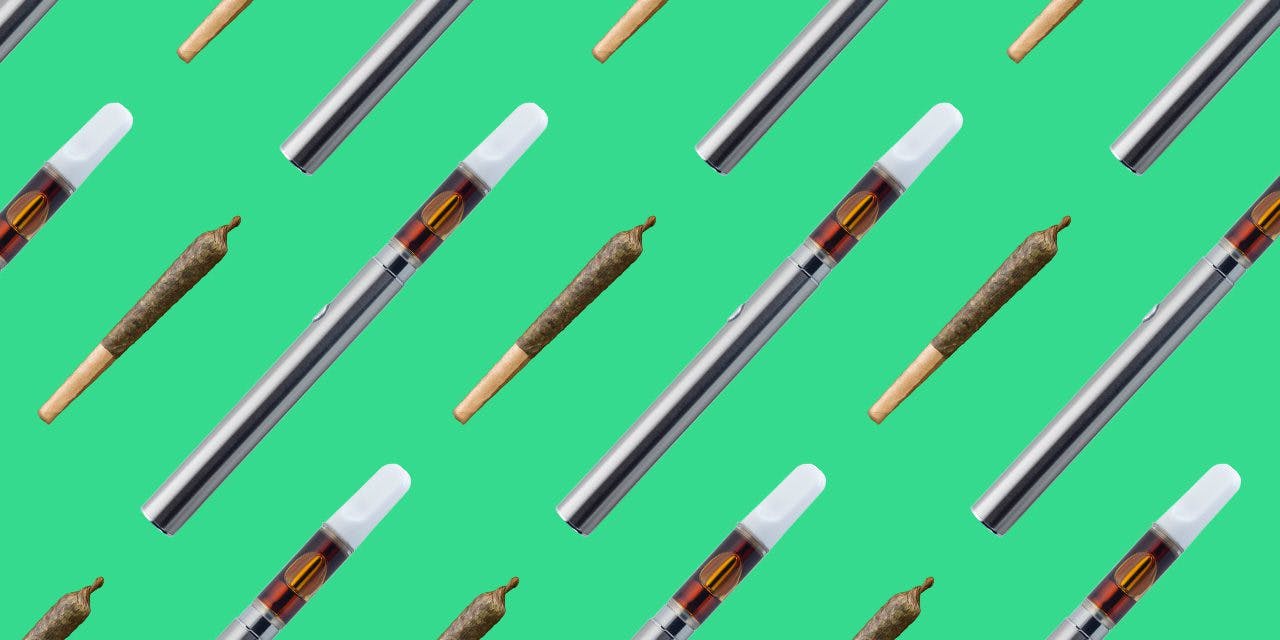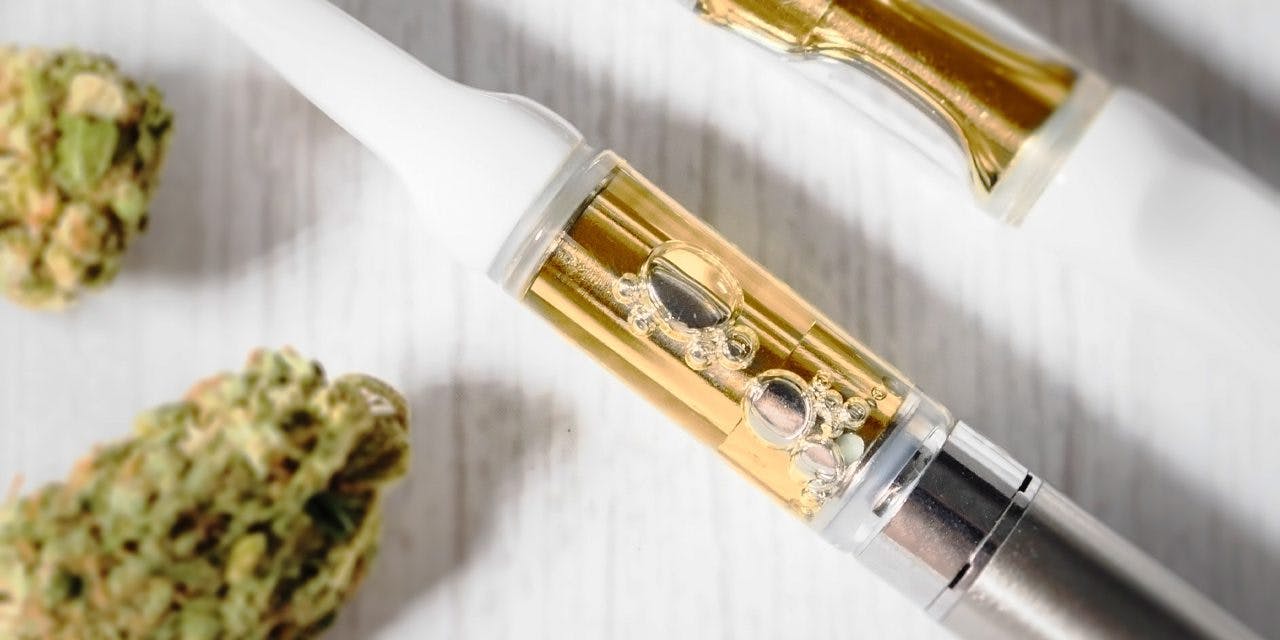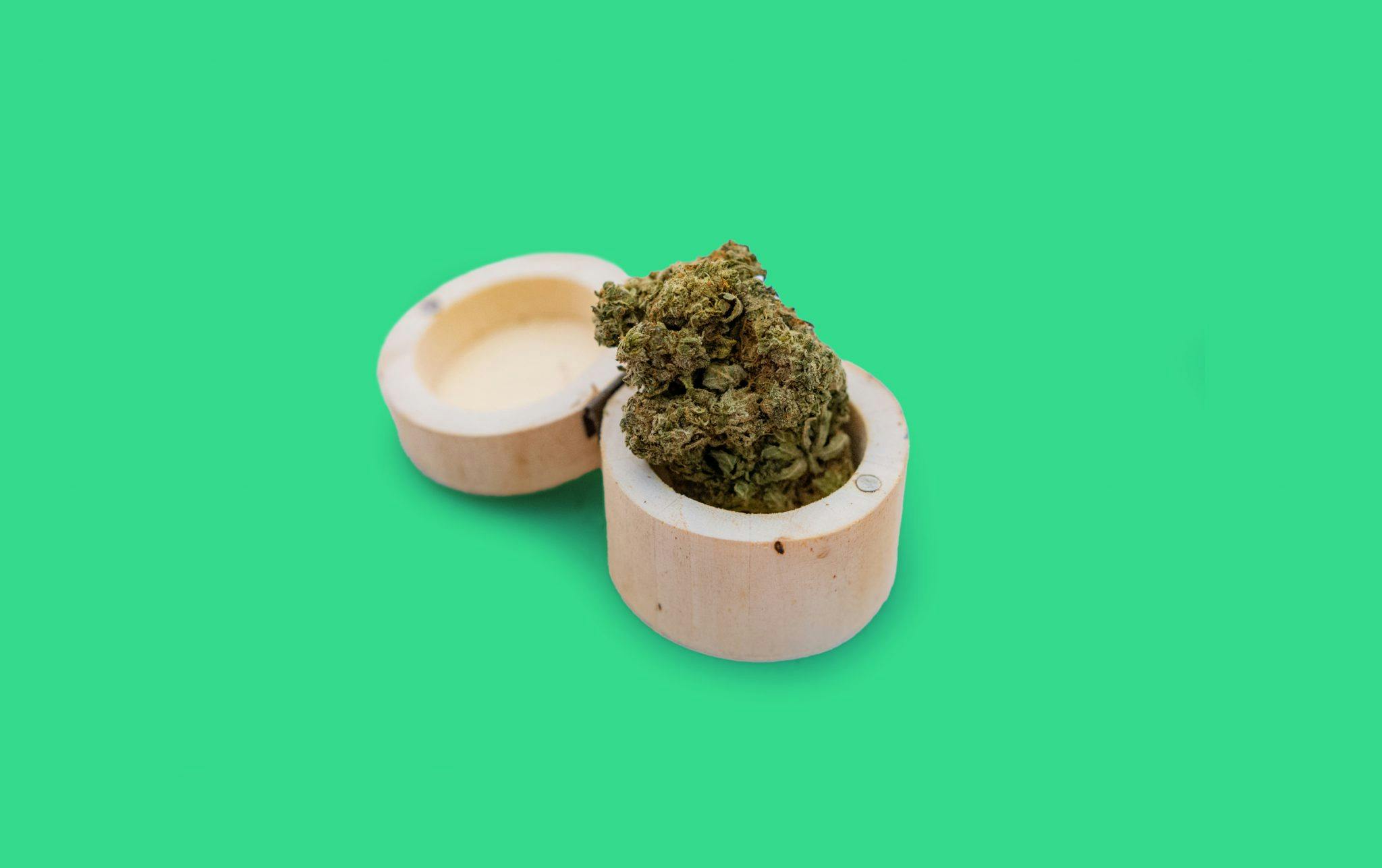Vaping vs. Smoking Marijuana: Is One Better Than the Other?

Article written by

Shanti RyleContent Writer
Content reviewed by

Dr. Lewis JasseyMedical Director - Pediatric Medicine
Vaping and smoking both involve inhaling, but the main difference is that vaping involves heating a cannabis-based oil with a device. At the same time, smoking typically means inhaling the smoke from cannabis flower rolled into a joint or cigarette.
Both ingestion methods have a list of pros and cons, with neither necessarily beating out the other in terms of the better consumption method.
Get your medical marijuana card
Connect with a licensed physician online in minutes.
Vaping Marijuana
Vaping cannabis has become a preferred method of cannabis consumption, thanks to the perception that it’s healthier than smoking. Like electronic cigarettes with tobacco, marijuana vapes work by heating cannabis oil into a vapor, which the user inhales. Cannabis vape pens often resemble other e-cigs and electronic tobacco products – they just contain cannabis instead of nicotine.
Risks
Vaping may appear a healthier method of inhaling cannabis, but this is far from the truth. We don’t yet have the research available to determine whether vaping is a safer long-term consumption method than smoking, but there are other risks.
There are plenty of poor-quality vaporizers on the market, made with fragile plastic parts that you don’t want to inhale. Disposable vapes are also formulated with suspended cannabinoids in a solution, which may contain toxic chemicals and dangerous additives like vitamin E oil, a carcinogenic that can cause lung damage. In several recent instances, products have been recalled due to safety concerns and unreliable lab test results.
In both legalized markets and the non-regulated hemp oil market, disposable cannabis vaporizers have been found to contain synthetic cannabinoids. We don’t yet know the effects of synthetic cannabinoids on the body, which could be more dangerous than phytocannabinoids sourced from the flower itself.
Vaping also makes consistent dosing tricky, as you can’t easily measure the intake of a specific amount of cannabinoids per inhale. It can be easy to over-consume if you’re a first-time user, resulting in an unenjoyable effect from a too-heavy hit. It’s important to start slow and gradually identify your limits and how your body reacts to vaporized cannabis.
Benefits
If you get your hands on a high-quality vape product, however, there are several reasons why you might consider vaping as your choice for consuming cannabis.
As vaporizing cannabinoids immediately introduce them to your lungs and bloodstream, you more quickly feel the effects of the medicine. Vaporizing also produces no smoke – making it discreet, free of lingering smells, and less likely to bother others in the vicinity.
While we mentioned the challenges of dosing vape pulls above, it is still easier to measure your dosage than with flower. A smaller amount also goes a long way, and vaporizer batteries are reusable, potentially providing a more cost-effective solution.
Smoking Marijuana
Smoking cannabis is one of the oldest consumption methods, tried and tested by most cannabis enthusiasts in recent decades. One simply ignites the flower, packaged in a bowl or rolling paper, and inhales the smoke. However, due to potential health concerns, smoking cannabis is fast becoming less and less popular, particularly among medical patients.
Risks
Some may argue that cannabis smoke isn’t as harmful as tobacco smoke, which doesn’t absolve it from all potential harm to the throat and lungs. Breathing in smoke can risk inhaling carcinogens and damage, especially for medical users.
When flower combusts, the high temperature of the flame burns off some of the cannabinoids and terpenes, which theoretically makes smoke a less efficient and less long-lasting experience than vaping. Smoke is also the most noticeable way of ingesting cannabis, both smelly and irritating to others.
Flower products may be of dubious quality, too, with some growers using pesticides or water with heavy metals to raise their crops. Rolling papers can also contain their own damaging compounds, and while some brands are safer than others, you’re still adding to the burned matter. Blunt wraps are made with tobacco, which can be harmful when inhaled.
Both minors and those who are immunocompromised or have breathing issues should avoid smoking cannabis and opt for another consumption method,
Benefits
Some users, however, prefer to smoke flower over any other consumption method, and there are several good reasons why you might enjoy it. Many simply enjoy the flavor and aroma of smoking cannabis, appreciating the terpenes and flavonoids unique to each strain (variety).
Smoking instantly transfers the cannabinoids and terpenes to your lungs and bloodstream, allowing immediate effects for those who need relief quickly. It’s also a straightforward process, requiring far less technical know-how than vaporizing concentrates. One can dose with relative consistency, though the cannabinoid profile of flower varies from crop to crop and strain to strain.
Alternative Methods for Consuming Marijuana
You may feel that neither smoking nor vaping cannabis is the best option, given the above concerns. Here is a list of alternative options to ingest cannabis.
Edibles
Edibles offer a longer-lasting, tastier method of consuming cannabis. For years, however, edibles were often made into sugary treats to mask the taste of weed. While many healthier recipes are available today, infusing cannabis into desserts is still quite popular.
Edibles are much more psychoactive and longer-lasting than smoking or vaping cannabis. This is because cannabis is digested and enters the bloodstream through the liver, converting THC into the highly potent 11-hydroxy-THC.
Free Pot Brownie Recipe Download
Tinctures
Tinctures make for a convenient, discreet, and fast-acting method to ingest medical marijuana. They are also flavorless and easy to place directly under the tongue or add to any food or beverage recipe. Well-made cannabis tinctures feature coconut, MCT, or olive oil as a carrier for a solution of cannabinoids and terpenes.
Inhalers
While smoking and vaporizing cannabis seems a lot less medically-minded, cannabis inhalers couple the immediate effects with a more discreet image. Inhalers can be helpful in soothing conditions such as asthma, multiple sclerosis, or sudden panic attacks without needing smoke or vapor. Measuring cannabinoid intake is also a lot simpler with inhalers.
Capsules
Many medical users opt to use cannabis capsules, often referred to as THC pills. These tablets are taken like any other medication and offer a precisely dosed method of cannabis consumption. However, capsules take slightly longer to digest than edibles, so relief – while longer-lasting – is slower to take effect.
Topicals
There are many different types of topicals on the market to help with various needs, such as muscle pain and dermatological conditions. Topicals quickly absorb into the skin where needed and act on the area’s endocannabinoid receptors to provide relief.
The Bottom Line
So which is the better way to consume cannabis, smoking, or vaping? Each comes with its pros and cons; the choice depends entirely on the consumer’s specific needs and conditions. It’s best to connect with a doctor to understand whether smoking flower or vaporizing weed may be best for you.
Get Your Medical Card
Connect with a licensed physician online in minutes.
Frequently Asked Questions
Which is better for lungs, vaping or smoking?
Both vaping and smoking share similar harms, containing potential carcinogens, causing damage to the lungs and throat, and increasing the risk of cancer. Recent studies have uncovered more about the long-term effects of smoking cannabis than those of vaping. So while we know that smoking cannabis can cause long-term harm, we’re unsure whether vaping can.
How does smoking feel compared to vaping?
Vaping and smoking cannabis produce similar effects once in your system. Vaping cannabis can result in less coughing and a comparatively minor burning sensation since vaporization temperature is lower than combustion.



